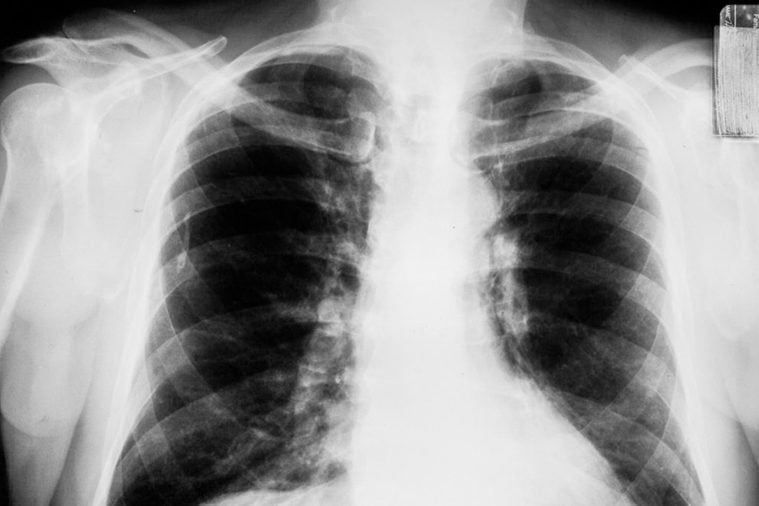How I Got Lung Cancer at 31—Without Ever Smoking a Single Cigarette
Updated: Jan. 15, 2019
Rachael Malmberg was 31 when she received a deadly diagnosis. She is fighting her condition and has embarked upon a mission to educate others about the second leading cause of lung cancer—and it has nothing to do with smoking.

Rachael Malmberg was enjoying the 2016 Thanksgiving holiday in Florida with her family when trouble hit. She was out for a run, and suddenly a pain that radiated from her neck to her rib stopped her cold. She was 31 years old at the time and an accomplished athlete. Malmberg was used to pushing through discomfort; she had a high tolerance for pain. But when her mother noticed that Malmberg couldn’t finish her workout, she convinced her daughter to see a physician. The Watertown, Minnesota, native agreed: This pain wouldn’t respond to physical therapy or bed rest.
“The doctor told me I was working out too hard and to take it easy,” Malmberg recalls. “I knew that wasn’t it. I wasn’t doing anything unusual during my workouts.” The pain worsened, and then she began to feel soreness under her arm. She also developed lumps in her breasts, although doctors determined that they were benign.
When the pain in her armpit would not relent, Malmberg knew she needed to push the issue. Her obstetrician turned down Malmberg’s request for a breast MRI. Malmberg flew to Michigan to get the scan with another physician. “My breast looked great, but they found a mass on my lung,” Malmberg recalls. Here are the 11 things about lung cancer doctors wish you knew.
“I had a CT scan the same day, and due to the fact that I had no symptoms of cancer and I’m young, the doctor thought perhaps a recent strep throat infection had developed into pneumonia,” she explains. Malmberg was given antibiotics for ten days and told to repeat the CT scan to reassess the mass. “When the second CT scan came back with no change, that was when reality hit that something was very wrong,” she recalls. After an abnormal bronchoscopy (a way of retrieving lung tissue through the throat for biopsy), she received the startling news that she most likely had lung cancer.
About 230,000 Americans are diagnosed with lung cancer yearly, according to the American Lung Association, and it’s the leading cause of cancer deaths. Typically, smokers or industrial workers have the highest risk, but Malmberg didn’t fall into either of those categories. What she didn’t realize is that her home was exposing her to the second leading cause of lung cancer: radon. The odorless, colorless radioactive gas seeps up from the soil and can collect in some houses. Learn the 15 things in your home that can cause cancer.
“I got the diagnosis of adenocarcinoma, and I figured it was stage 1—something we could treat and knock out,” Malmberg recalls. When further testing revealed that the cancer had spread to both her lymph nodes and brain, Malmberg was devastated, but as a married mom (she has a young daughter), she quickly moved on to learning all she could about her condition and her options.
Lung cancer often shows no symptoms in the early stages, but symptoms can include a nagging cough that won’t go away, coughing with blood, fatigue, weight loss, and new aches and pains in the chest, back, or shoulder. Take a look at these 7 signs of lung cancer you could be ignoring.
“I remember sitting in the waiting room before meeting with the oncologist and Googling everything. I knew going in what I was going to hear—I wanted to be prepared,” she recalls. Steeled and determined, Malmberg made the decision to fight. “I was feeling like I was going to beat this. I had accepted it as God’s will; I just wanted to know what my next step was,” she says. Malmberg underwent targeted radiation on two inoperable tumors in her brain; she also got surgery to remove the lymph nodes in her chest and the middle and partial upper lobe of her right lung. She then began a targeted drug therapy to prevent new cancer growth, which has been successful for nearly a year in keeping her cancer in check. “It’s allowing me to live my life instead of cancer living it for me,” she says of the drug.
With cancer no longer the center of her attention, Malmberg has set her sights on the future. She plans to run a marathon and continue to educate others about the dangers of radon. “My home tested positive for higher-than-normal levels of radon, and we are testing the home I grew up in as well. It’s about finding a ‘why’ at this point, and protecting my family,” Malmberg explains.
“Cancer has given me a new perspective on what’s really important,” she says. “I was type A, and so driven. Now I ask, do I really need to do everything, and how can I help others?” she explains. “God chose me to go through this for a reason, and I see it as a blessing now. I can be a shining light, and a voice for those that aren’t strong enough to use theirs,” Malmberg says. She has a message for people experiencing the shock of a new diagnosis like lung cancer: “You don’t need to act immediately, even though there’s a lot of pressure to make quick decisions. Take a step back and breathe. Be your own advocate. Your doctor is there to be an expert and a guide, but you need to decide for yourself what you want.” Watch out for these 7 silent signs that your lungs could be in trouble.
